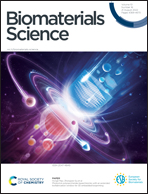Synergistic effects of nanoattapulgite and hydroxyapatite on vascularization and bone formation in a rabbit tibia bone defect model†
Abstract
Hydroxyapatite (HA) is a promising scaffold material for the treatment of bone defects. However, the lack of angiogenic properties and undesirable mechanical properties (such as fragility) limits the application of HA. Nanoattapulgite (ATP) is a nature-derived clay mineral and has been proven to be a promising bioactive material for bone regeneration due to its ability to induce osteogenesis. In this study, polyvinyl alcohol/collagen/ATP/HA (PVA/COL/ATP/HA) scaffolds were printed. Mouse bone marrow mesenchymal stem/stromal cells (BMSCs) and human umbilical vein endothelial cells (HUVECs) were used in vitro to assess the biocompatibility and the osteogenesis and vascularization induction potentials of the scaffolds. Subsequently, in vivo micro-CT and histological staining were carried out to evaluate new bone formation in a rabbit tibial defect model. The in vitro results showed that the incorporation of ATP increased the printing fidelity and mechanical properties, with values of compressive strengths up to 200% over raw PC-H scaffolds. Simultaneously, the expression levels of osteogenic-related genes and vascularization-related genes were significantly increased after the incorporation of ATP. The in vivo results showed that the PVA/COL/ATP/HA scaffolds exhibited synergistic effects on promoting vascularization and bone formation. The combination of ATP and HA provides a promising strategy for vascularized bone tissue engineering.



 Please wait while we load your content...
Please wait while we load your content...